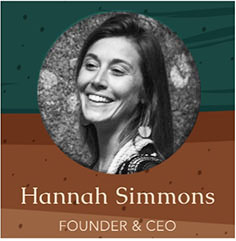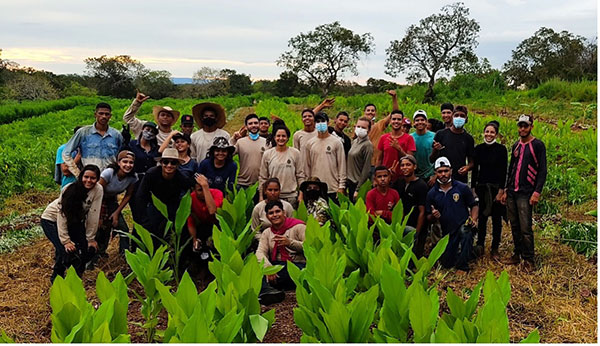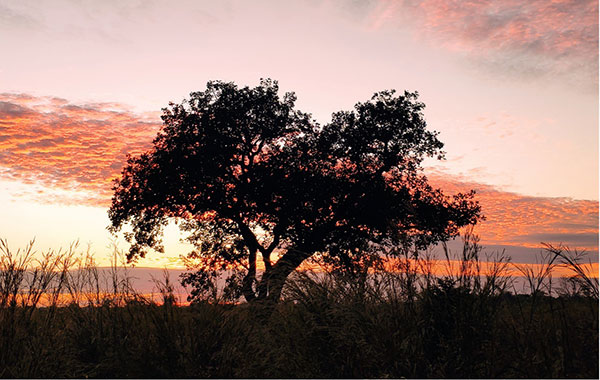Carbon Conversations: Talking Teams, Financing Partners, and the Importance of Multiple Impacts

Carbon Conversations is a new series of Q&A sessions with leading carbon sector executives. For our first post, we sat down with Hannah Simmons, founder and CEO of Ecosystem Regeneration Associates (“ERA”), which is responsible for protecting 11,000 hectares of the vital, and highly endangered, Cerrado biome in Brazil. The Cerrado is one of the largest, most biodiverse tropical savannas in the world and home to 5% of the world’s species and 30% of Brazil’s biodiversity. The region also serves as an aquifer during the rainy season and feeds many of the major rivers of South America. Carbon Streaming entered into a carbon credit stream agreement with ERA in September 2021 and the first credits under that stream are expected to be delivered this year.
Carbon Streaming: Hannah, thank you for taking the time to speak with us. Perhaps we could start with you telling us how long you have been working in emissions reduction and carbon removal projects?
Hannah Simmons (ERA): Thank you for having me! I have worked in carbon offsetting since I graduated. Actually, I’d go back even earlier because I started working in carbon when I was sixteen because my Dad works in carbon. So, as a teenager I was potting trees and organizing the nursery for a reforestation carbon program in Vancouver.
I then went to McGill University to study environmental sciences, and right afterwards my first job was at a carbon project developer in Calgary because Alberta had Canada’s first official carbon market. It was a great experience because I learned about developing methodologies and project development, but eventually I thought to myself, reducing emissions using technology is crucial, but I want hands-on experience working with communities and nature-based solutions. So, I quit my job, left Calgary and headed south. I backpacked for 6 months throughout South America, and Brazil was the last country I visited. I decided I could find what I was looking for in Brazil because my skill set was all about carbon and environmental markets. Ultimately, that led to founding ERA and launching this project in the Cerrado.
Carbon Streaming: What have you found to be the biggest obstacles in setting up a new project?
Hannah Simmons (ERA): Top of the list is finding the right team. And I’m not talking about finding people who are committed to protecting the environment because more and more people are waking up to climate change and they want to make a difference. The biggest obstacle for a new project is building a multidisciplinary team.
Carbon offsetting involves the use of strict methodologies. It’s a recipe and you need to follow that recipe to the letter. And it can be quite a complicated recipe for someone who is not well-versed in the carbon market lingo and procedures. You know, what is additionality? What is permanence? You need to unpack a range of concepts in order to understand market mechanisms, and how carbon project development happens in practice.
You need someone who understands remote sensing because you’re going to be gathering and processing large amounts of data which involves setting up baselines and modeling. You need to have a forest engineer. You need to have someone who understands biodiversity and can set up camera traps to detect animals. You need someone who understands finance so that you can determine the financial viability of the project because all of this takes money. You need a lawyer, and then of course you also need project managers. And these people need to be very methodical, people who can roll out the project step by step and put everything into place.
And then for projects like ours, you need to add a layer of English. We’re working in Brazil where the primary language is Portuguese, but all the documents are in English. The language factor is a big barrier to entry for a lot of projects. And most of the conservation and reforestation work that the world needs is in non-English speaking countries.

Carbon Streaming: Let’s talk about the steps required to get a carbon project verified.
Hannah Simmons (ERA): Perfect! So first, you need to write a PIN, which is a Project Idea Note, which is basically a concept of the project. You have to state exactly what kind of project you will be doing, and by that I mean methodology. You can choose from about 50 methodologies out there, depending on what kind of industry or project you want to do. The PIN alone can take months to complete properly.
After that, you need to write a Project Design Document (PDD). You have your idea but what is your plan? How are you going to implement your project? What data are you going to be monitoring? How are you going to be monitoring that data? What are the stakeholders you’re impacting? What are the benefits you expect? So, it’s this whole project plan and we’re talking about a 200+ pages! The PDD must then pass validation.
Validation occurs when you hire a third-party company to see if your plan matches the standards set out by the standards agency like Verra, Gold Standard, and so on. So, if you’ve done everything correctly, the validator comes in and says, OK, your plan matches the methodology, you can continue and take your project to the next stage. The next stage is project implementation where, for example, the project developer will implement activities to reduce deforestation, or increase carbon removals through tree planting and ecosystem regeneration.
After that you have the monitoring stage which can last for many months and even years. Once you are at the end of your monitoring period, you gather the data outlined in your PDD and plug it into the model that you have developed to calculate the number of carbon credits.
In the monitoring plan, project developers must also present details around the co-benefits the project has generated, other than the carbon benefits. This follows a separate co-benefits methodology, for example, the Climate, Community and Biodiversity Standard (CCB). Carbon offsetting projects are moving beyond just reducing carbon. Today, projects need to have additional impact. For example, you’ve reduced or avoided say five million tonnes of carbon which generates your credits, but what other positive effects have you had on communities and biodiversity? How many people from the local communities have you trained? How many have you educated? How did you help the local wildlife?
It’s the carbon credit buyers who are really driving the additional impacts aspect of the industry because they don’t just want to know they are financing a reduction in carbon; they want to be positively impacting a range of environmental and social issues. This is what sets apart a high-quality carbon credit from the other carbon credits.
Once you gather all the data in your monitoring report, you hire a third-party verifier to assess the monitoring report and calculations. It can be the same third party that validated your program. They come in and they say, “let’s see if the data and the monitoring report matches your plan and matches the standard.” If it does, you get a validation report! And you send that to the standards agency to be approved, and they serialize your carbon credits, which get transferred to your account and then you can sell it to any of the buyers out there.
It sounds like a lot and, well, it is.
Carbon Streaming: Okay, let’s say that you have a project up and running, fully certified and you’ve received your first batch of credits… do you ever have to be re-verified?
Hannah Simmons (ERA): Every time your project generates carbon credits from a new monitoring period, you need to get re-verified. For example, with REDD projects like ours, the lifetime of the project is 30 years. So, let’s say your monitoring period covers five years then you’re going to have six verifications over the lifetime of the project.
Carbon Streaming: We’ve talked about some of the hurdles that pretty much all carbon projects face – building a skilled, multidisciplinary team, getting through the validation and verification process. How about the hurdles faced by specific project types? For example, what is ERA’s greatest challenge now that the project is up and running?
Hannah Simmons (ERA): Well, every project is going to be unique to some extent but yes, looking at our project as an example, we have a grouped project and we’re dealing with landholders on a daily basis, so I’d say landholder engagement is our biggest barrier because we’re competing directly with commercial agriculture. Landholders typically make an economic decision when it comes to land use. Returns from soy are higher today than returns from REDD+ carbon payments. Money talks and you know that agriculture is big, big business here in Brazil. We need higher carbon prices to make projects like ours scale to the size where they’ll be cutting emissions throughout Brazil.
Carbon Streaming: This is a good segue to move to the money side of the equation. I’m specifically talking about getting funded. How easy is it to find funding to both start and expand your project?
Hannah Simmons (ERA): If you had asked me this question just a couple of years ago, I’d have given you a very depressing answer. It used to be incredibly hard to find funding, or at least to find a funding partner willing and able to work with you in the right way. You’d get some of the big carbon credit traders with money but most of them wanted to load up on cheap credits. The understanding of what these projects are really for, and the patience required to get it right, wasn’t there a lot of the time. There was always a certain amount of money trying to find good projects, but it wasn’t plentiful.
But that has changed since the pandemic. Suddenly people had more time on their hands. We started to see people really get more engaged and paying attention to how we solve the climate change problem. It was apparent in two major ways.
The first was the increase in the price of carbon. Companies are stepping up, creating more net-zero commitments and those commitments are creating more demand for credits. But the supply is not there, so the price goes up.
The other major change was the number of companies looking to fund project developers. Suddenly, I started getting all these funds and investors coming to me with money and saying “Hey, do you have more projects available because we want to invest in you?”
And with the increase in companies looking to fund projects there has also been a big change in the quality of funding partner. Carbon Streaming is the perfect example because instead of being a partner wanting us to churn out credits cheaply and quickly, they said right at the get go that they wanted a project developer that was focused on impact driven projects, you know, projects that deliver more than just credits. They understood the timescales involved, and that quality and impact was the core goal. They’ve been extremely approachable and supportive throughout and we’ve formed a genuine partnership.
So, I guess I’m saying that funding is no longer a major challenge if you have the right team in place and the right project, which is a pretty big change from the earlier days of carbon projects.
Carbon Streaming: Let’s move on to the role and potential of carbon credits as an effective tool in the fight against climate change. There are a lot of supporters for carbon credits, a lot of people working hard on projects that tackle emissions. But there are also people that claim carbon credits are ineffective in reducing emissions and that they are simply a license to pollute. What do you say to those people and to investors looking to support the carbon credits industry?
Hannah Simmons (ERA): Well, a couple of things. Not all projects are created equal. That’s especially true for those that were set up in the earlier days of carbon offsetting. Carbon credits have been around for about twenty years but in the early years there was a big lack of understanding on the part of those who were setting the rules, creating the verification standards, and to be honest, on the part of many project developers. Climate science is complicated and it’s a steep learning curve.
The result was that some of the projects were not designed or implemented, or verified, in a way that has made much of a difference to climate change. And if you’re someone who wants to point out flaws in carbon offsetting then you can find projects that will fit your theory. The same is true of any industry really – quality is always going to be a factor.
I think it’s more important to look at the verification standards as they are now, and at the quality projects that have been validated and can prove they are making a difference.
Calling carbon credits a license to pollute shows a lack of understanding of the current state of play for carbon reducing initiatives as well as the path that companies have to take to reduce their footprint. Companies should reduce in-house within their fence line, and mitigate whatever is left each year as they decarbonize. There are industries out there that won’t be able to get to net-zero without carbon credits.

But you know there is one last thing that I wanted to add that I think is really important, a lot of project developers are called carbon project developers, right? I think we all need to start getting away from this carbon-centric worldview. As a global society trying to decarbonize, we have targets to meet to avoid disastrous impacts. But we can’t forget the other elements of the Sustainable Development Goals (SDGs) that are just as important for adaptation. I’m talking about things such as water conservation, women’s empowerment, biodiversity, food security. So, ERA is now kind of rebranding ourselves. Instead of a carbon developer, we are an impact developer, and carbon is one of the impacts that we deliver. And that means we’re working with other methodologies, such as the W+ standard to create women’s empowerment credits and building new methodologies such as the Flagship Species Biodiversity methodology to create biodiversity tokens. We’re creating these stacked benefits of impact for the actions that we’re doing on the ground. And I think that’s really key. It’s also why we connected so well with Justin and the team at Carbon Streaming because they are really focused on impact investing, so we have a similar world view.
Carbon Streaming: Hannah, thank you so much for speaking with us today.
You can find more information on ERA’s project by visiting our Cerrado Biome Project page or by visiting the ERA website.
Stay up to date with the latest Carbon Streaming news and new Carbon Blog posts by signing up to our email list and following us on Twitter and LinkedIn.
Forward-Looking Information: Some of the posted entries on the Carbon Blog may contain forward-looking information. Forward-looking information address future events and conditions which involve inherent risks and uncertainties. Actual results could differ materially from those expressed or implied by them. For further information about the risks, uncertainties and assumptions related to such forward looking information we refer you to our legal notice.